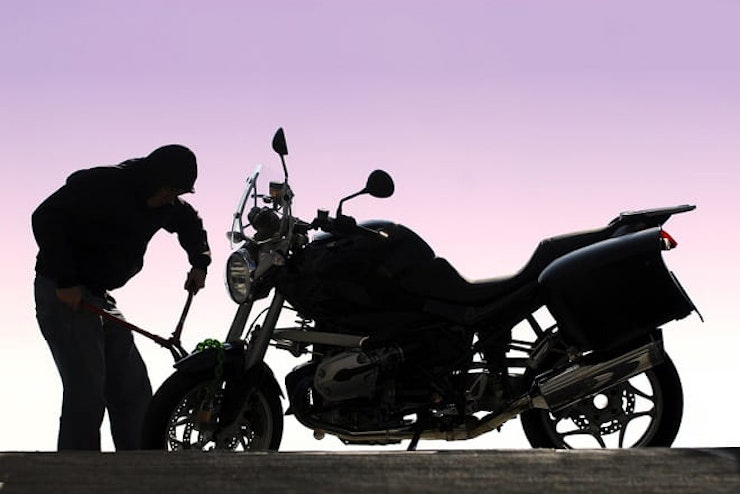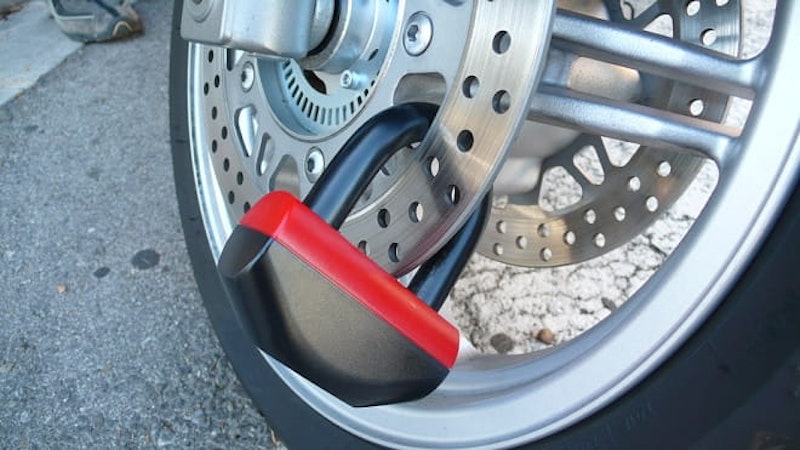Organised ride in London aims to raise awareness of motorcycle thefts
By Michael Mann
BikeSocial Managing Editor
03.11.2016
This Sunday hundreds of riders are expected to take part in a demonstration ride to raise awareness of the increase in violent robberies and thefts of motorcycles and scooters in London.
The ride, dubbed ‘Stop Escalation of Motorcycle Thefts in London’, has organisational support from the Greater London branch of MAG (Motorcycle Action Group) and departs the Ace Café at 10.30am heading to Downing Street to hand in a petition before completing the ride in Parliament Square.
Last year we reported the worrying statistics that motorcycle theft is on the increase for the first time in 5 years with 22,500 bikes stolen in the UK the previous year and what’s more, the recovery rate for stolen machines (40%) is getting worse.
For every five motorcycles and scooters stolen in the UK this year only two are expected to be recovered.
While the total value of thefts expected in the UK this year is £13.5 million pounds the true cost born to the public, the police, the insurance industry, manufacturers, dealers and those in credit and finance industry will be a staggering £182 million pounds. And that’s without the personal pain of walking back to your bike and realising it’s gone.
About Sunday’s demonstration ride, Greater London MAG representative, Tim Fawthrop, told BikeSocial, “A Facebook page was started by Emanuel Barb after the murder of Ricky Hayden in Chadwell Heath in September. I as MAG regional rep for Greater London MAG was starting to get an awareness ride organised when I was told abut Emanuel's page so we let him take the lead and we've been organising the logistics to raising the awareness of the volume of robberies in Great Britain, especially London.”
Mr Fawthrop continued, “As you can see the post have gone, in a majority of cases, from aggressive to ways and means of helping the Police with intelligence and getting people to lock their bikes every time with the correct security. Also to encourage the Metropolitan Police to reopen the dedicated bike theft unit.”
Understandably, organised crime gangs not just from the UK but those syndicated with others in Europe are very interested in stealing good quality, high value motorcycle and scooters and delivering them to where the money is. To them it’s a relatively easy crime which supports their other illegal businesses.
What bikes are being stolen? Simply those that sell well such as 1 & 2 year old Honda, Yamaha, Suzuki, Kawasaki, Ducati & BMW superbikes plus Vespa and Piaggio scooters are the key targets for professional bike thiefs.
Ten Top Tips to prevent your bike being stolen
by Dr. Ken German, Vehicle Crime Consultant and retired police officer with 25 years served in the Metropolitan Police Stolen Vehicle Squad:
1 - Whenever you park your bike ‘Do Something’ to prevent it being stolen.
Seems obvious, but the figures show that many riders do nothing when they park their motorcycles. You need to at least engage the steering lock and any other manufacturers’ security device that is fitted to your bike.
A recent survey shows that 70% of machines parked in motorcycle bays had no visible signs of any secondary security fitted to them! Unsurprisingly 75% of machines were stolen from commuter parking bays.
2- Stop your machine being moved - fit a lock.
When you park your bike secure your chain, disc lock, U shackle, clutch grip etc and set your alarm or immobiliser and ensure you tracking device is working.
Prevent the bike being ‘pushed’ away by fitting a quality chain around your rear wheel and frame and use a disc lock as a supplementary device. Thieves have been found to carry ‘spare’ front wheels for machines they are after to fit in the event of a locked front wheel having to be removed.
Fit a U shackle, although you will need a large one to fit around a ground anchor or something solid you can secure the bike to. Many designated parking bays are now fitting useful security anchors for motorcycles.
The most common form of theft nowadays is by ‘freeing’ the machine from any lock etc (if there is one fitted) and ‘riding’ the bike away. This is done without the engine being started and by an accomplice usually riding a scooter pushing the rider along on the stolen machine with his foot on the footrest, usually to a garage where alterations or stripping takes place.
3 - Do your research and consider fitting a tracking device.
Not everyone can afford one of these but several good arrests were made and high value motorcycles recovered last year because a tracking device was fitted.
There are now quite a few on the market and some are reasonably priced. It is however important that research is done and comparisons are made as to what they individually offer and their specifications do vary. Ask about any successes made in previously tracing and recovering vehicles.
Finding stolen bikes on the move is rare. Signal penetration is important particularly if a stolen bike is hidden in a van, container or building. Ultimately the machines static location needs to be located before there’s any chance of the police effectively becoming involved.
These should definitely be considered if you have one or two year old superbike, or expensive classic bike, some of which are worth £10,000 and more.
Bizarrely, Harley Davidson machines are some of the most expensive bikes available and they do have the most identification of any bike out there. The anomaly is that only 5% of those stolen bikes ever get recovered.
Thieves will usually ‘park up’ the stolen machines for a few days if they suspect a tracking device is fitted to see if a signal has been sent and the machine recovered by police.
4 - Fit a Thatcham approved alarm or immobiliser.
Alarms have had a bad press in recent years and the argument always seems to revolve around who can hear them and who can respond to them.
Sure, if a thief is dressed as a motorcyclist then maybe no one bats an eye lid as it’s loaded onto a van. That may have been the case once but an increase in vehicle crime has encouraged a change to both local policing attitudes and in the public’s perception of crime awareness.
Whilst alarms have proved effective for some and not for others they should be considered as an important security device particularly around the home IE garage, driveway and garden etc where they have proved to be effective.
Why Thatcham approved? Simply because the alarm or immobiliser will be recognised by your insurance company as will any other manufacturer-fitted motorcycle device. It will also ensure your discount if your insurance company offers one.
5 - Secure your garage.
Garage thieves work mainly at night. Whether your garage has been seen by thieves as one to burgle, or you have been followed home in order to see where you park the bike, your garage may become a target so make sure it is secure.
Garage alarms, strong doors, secure windows and ground anchors should all be considered because an easy entry into your garage can give thieves both cover and time to remove anything inside. Always use your secondary security even inside your garage.
Don’t leave your bike outside your home at night, but if you do, make sure it is covered and the alarm set.
If you are away from home make sure you nominate a friend or neighbour to monitor your property and garage. Security lights can also put a potential thief off.
6 - Mark your machine with both overt and covert marking.
There is divided opinion as to why you should mark your machine with covert markings, invisible DNA and stickers showing this has been done.
Whilst it does not prevent your bike being taken, it is a proven deterrent. Machines have been successfully stopped by police and marks found have established ownership and theft. Suspected stolen spare parts found have also been examined and their true provenance found.
Quite often police struggle to identify cloned machines that have their normal identification removed and spare parts found. These marks ensure thieves can be charged with theft and satisfaction is achieved when machines are recovered and returned to their owners or insurance companies.
7 - Cover your bike when parked.
Recent local police initiatives have shown that bike covers can be a useful anti-theft device. They are easy to carry and do not overtly advertise the fact that your machine is valuable or worthy of being taken.
Yes they take a few minutes to fit, and yes they can be cut-off by thieves. But lessons learned from those arrested suggest covers work. Coupled with secure locks fitted to ground anchors usually means owners have also fitted alarms, tracking devices, covert markings and probably other anti-theft equipment should their bike be tampered with.
Unless the machine is known to be highly desirable the thief may move on.
8 - Fit an ignition cut-out switch.
The most common method for organised crime gangs stealing high value and desirable machines is to either push them away from the scene or simply load them into a van. Their motivation is for profit only and that money is reinvested in other illegal businesses they have.
However, other motorcycle thieves however operate in a given area that use stolen machines for their own use or for stripping and selling the parts and selling them locally, or perhaps for racing.
Many attempts to take machines by starting and riding them away have been abandoned by thieves where owners have devised their own individual security such as cut out switches that prevent the engine being started.
These formed part of the 9000 machines that were stolen and recovered last year.
9 - HD & IP CCTV cameras, recorders and monitors.
CCTV systems are becoming more popular and can keep you informed as to what is happening around your home, garage and garden for relatively little money.
Used proactively, they can inform you by alarm of activities at your garage or simply record and store movement outside your house for your information.
If a burglary occurs and property is taken any useful pictures taken by the camera recorder could establish who the culprits are and be given to the police for their investigation.
The quality of some of these cheaper models however has made identification difficult.
This is clearly an area that will see quality improvement as cheaper models become available.
10 - There isn't a ten, but do all of the above and you'll have the best chance of keeping your bike away from thieving scum.
Share on social media:

